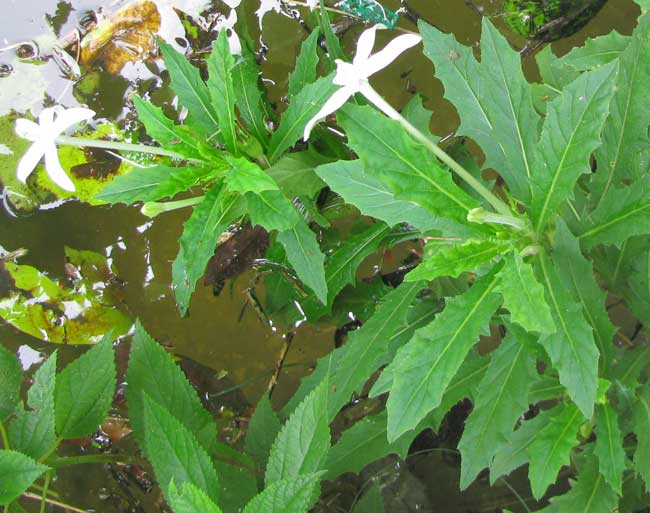Excerpts from Jim Conrad's
Naturalist Newsletter

from the July 18, 2010 Newsletter issued from Hacienda Chichen Resort beside Chichén Itzá Ruins, central Yucatán, MÉXICO; limestone bedrock, elevation ~39m (~128ft), ~N20.676°, ~W88.569°
HIPPOBROMA LONGIFLORA'S LONG WHITE FLOWERS
Down in the cenote's bottom where it was even more humid, in the mud there grew the knee-high herb with four-inch long (10 cm), white flowers shown above.
At first I had no idea what this might be but when I noticed how the flowers' five grown-together anthers extended from the corolla tube and curved up a little, just like anthers of the North's lobelia flowers, I figured it might be a Lobelia Family member. Checking genera in that family listed for the Yucatan it was easy to come up with the name.
It's HIPPOBROMA LONGIFLORA, in English often called Star of Bethlehem, but that name is more commonly applied to other plants, so it's an awkward one. Just call it Hippobroma. Nowadays the Lobelia Family has been lumped with the Bellflower Family, the Campanulaceae.
Damaged leaves and stems of this plant issue copious milky juice, which accounts for the Spanish name, "Lágrimas de San Diego," which means St. James' Tears. The juice is rich in two well known and powerful alkaloids, nicotine and lobeline, which affect human nervous systems similarly. Small doses of the juice may have medicinal value, but too much can induce vomiting, muscle paralysis and trembling. One web page advises wearing gloves when handling the plant since the sap can be absorbed into the skin and cause the above effects. Also, a little in the eyes can cause blindness. Medicinally, various cultures have learned to apply the plant to wounds to cauterize wounds and promote healing. It's been used to treat venereal diseases, asthma, bronchitis, "rheumatism," and even epilepsy and hydrophobia.
Hippobroma longiflora is native and endemic to the West Indies, but has become an invasive all through the American tropics and Oceania.